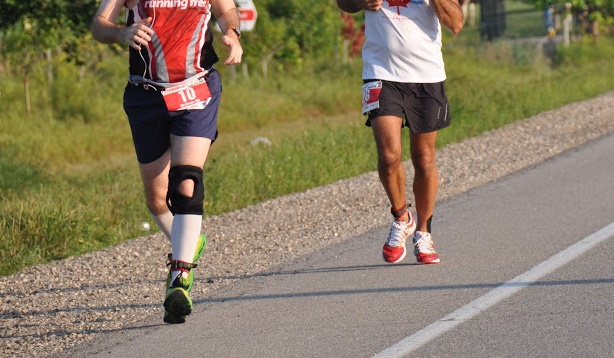We’ve heard of runners knee being more common in heel strike running than in forefoot strike running, but heel strike runners have another injury to worry about and that is persistent ankle pain, especially when they run at faster running speeds. How do we know this?

Heel Strike Running and Persistent Ankle Pain
A study by Peterson et al 2014 discovered that when heel strike runners increased their running speed from 7.96 km/hr to 15.91 km/hr, joint loading at the ankle was greater than the joint loading at the knee. During stance, ankle plantar-flexor moments around the ankle joint also increased with speed. The researchers described these finding as a burden on the plantar flexors of the ankle-joint which could make the ankle highly vulnerable to injury at faster running speeds in heel strike runners.
Comparatively, forefoot runners too, have a high ankle plantar flexor moment around the ankle joint, but the forward position of the center mass reduces the need for forward propulsion of the foot/ankle complex, suggesting that forefoot runners may endure less overall mechanical load on the ankle joint as compared with heel strike runners who rely mostly on the lower leg and feet for propulsion.
In general, heel strike runners have very high joint loading at the knee which is one of the causes of runners knee, but the recent study found that the joint loading at the ankle surpassed the joint loading at the knee as the speed of heel strike running increased –this just goes to show the severity of mechanical stress endured at the ankle in heel strike running. From this, the researchers concluded that the ankle has the potential to get more energetically taxed as compared to the knee-joint, suggesting that the ankles may fatigue quickly during long distance running if you use a heel strike landing.
More From Run Forefoot:
Other Injuries Caused by Heel Strike Running
Running Shoes That Promote a Forefoot Strike
Health Benefits of Forefoot Running
How Forefoot Running Boosts Performance
References:
Peterson et al. Comparisons of increases in knee and ankle joint moments following an increase in running speed from 8 to 12 to 16 km·h-1. Clin Biomech, 2014; 959-64.
Bretta Riches
BSc Neurobiology; MSc Biomechanics candidate, ultra minimalist runner & founder of RunForefoot. I was a heel striker, always injured. I was inspired by the great Tirunesh Dibaba to try forefoot running. Now, I'm injury free. This is why I launched Run Forefoot, to advocate the health & performance benefits of forefoot running and to raise awareness on the dangers of heel striking, because the world needs to know.
Latest posts by Bretta Riches (see all)
- Can You Run In Barefoot Shoes? Yes, But DON’T Heel Strike! - 21/07/2024
- Why Cushioned Running Shoes Are Really Bad for Your Feet - 19/07/2024
- Do Cushioned Running Shoes Cause Injuries? - 17/07/2024
